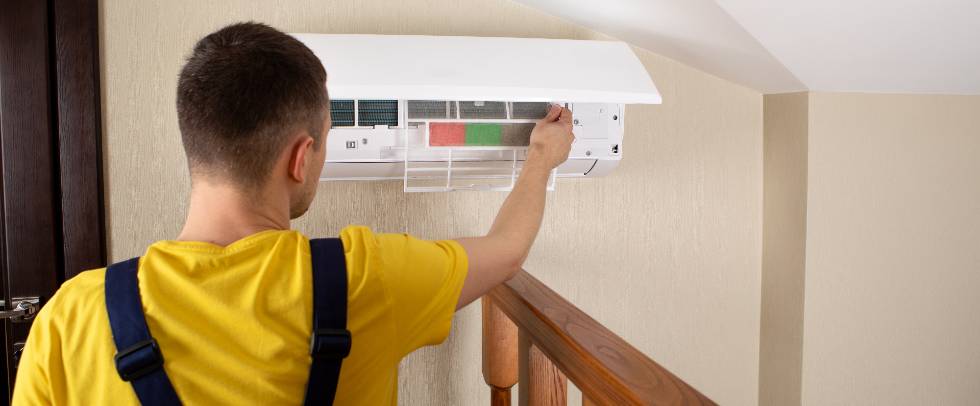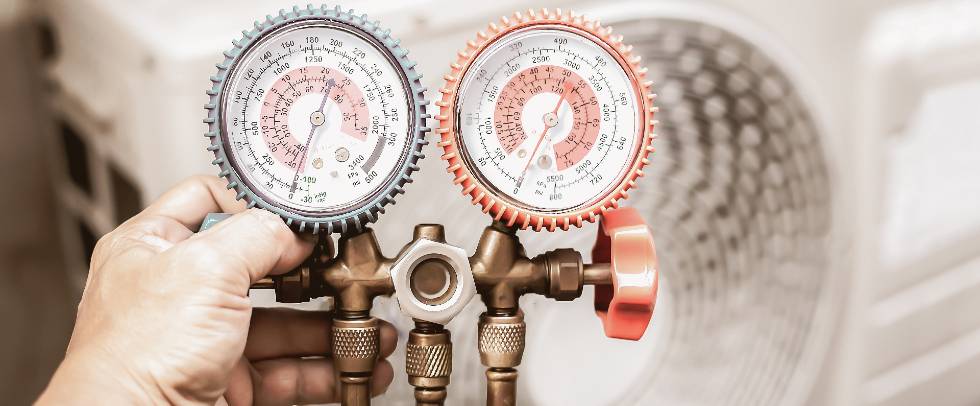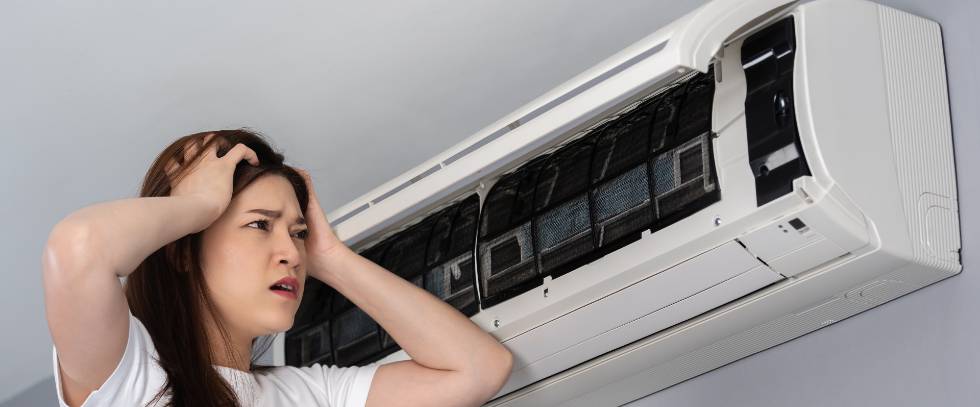Many Denver residents have yet to store their winter gear. With daytime temperatures in the 40s and nighttime temps dropping into the 30s, most people still wear coats and hats.
Don’t let the cooling trend catch you off guard.
You’re still turning up the heat for now. In a few weeks, you’ll set your thermostat to COOL and enjoy the comfort of your AC. What will you do if you turn your air conditioner on and discover trouble?
By reading this ultimate guide to DIY Denver AC repairs, you can avoid feeling the heat. We’ve included helpful tips and tricks to help restore the cool when the AC breaks down.
Read through the guide now and save yourself a little sweat later.
- Do You Have the Right Tools
- AC Anatomy 101
- Condensing Unit
- Evaporator Coil(or A-Coil)
- AC Will Not Turn On
- What to Do When You Don’t Feel Cool Air
- Cleaning a Condenser
- One More Component to Troubleshoot
- Do You Have a Clogged AC Drain Line?
- DIY AC Noise Troubleshooting
- Do you have Questions about DIY AC Repairs?

Do You Have the Right Tools for the Job?
Long before the AC breaks down, you should plan for future repairs. You might be thinking budget, but we’re talking about tools in this case.
Planning for an HVAC emergency means ensuring you have the essential tools needed for DIY air conditioner repairs.
If you’re not sure whether what you have right now in your toolbox is adequate, here’s a list of the basics you’ll want on-hand:
- Adjustable wrench
- Cordless drill
- Insulated screwdriver
- Needle-nose pliers
- Nut driver
- Socket/ratchet set
- Multimeter
- Voltage tester
Besides the multimeter and voltage tester, most homeowners already have the tools on this list. If not, who doesn’t enjoy a trip to the hardware store?
You may also be interested in: DIY Furnace Maintenance Guide
AC Anatomy 101
You can have the best-stocked toolbox in town, but it won’t matter what’s inside the box if you know nothing about a central air conditioner.
You don’t need to go back to school to learn about your cooling system. Take some time one evening after work and get to know your AC.
To shorten the learning curve, here’s what every AC system has under the hood (or behind the panels):
Condensing Unit
The outdoor condensing unit sits right outside your house. Inside the condensing unit, you’ll find the following components: AC contactor, start/run capacitor, condenser coil, and the condenser fan motor and fan blades.
A DIYer can replace these parts without too much fuss.
The compressor also sits inside the condensing unit. Unfortunately, if your compressor goes out, there’s no DIY fix. You’ll need to contact your air conditioner repair specialist.

Learn: 9 Common Air Conditioning Problems You Should Know About
Evaporator Coil(or A-Coil)
In most AC units, the A-coil sits on top of the furnace. Once you locate the A-coil on the heating system unit, you’ll see how it got its name.
From a DIY perspective, if anything goes seriously wrong with the evaporator coil, you likely will not be able to fix it yourself.
You should also see a disconnect box close by the outside AC unit. Since you absolutely must cut the power to the AC before you work on it, it’s a good idea to figure out the location of the disconnect box.
Now that you know what’s inside the box, we’ll look at the most common AC repairs DIYers tackle.
Your AC Will Not Turn On
After several months of not using the AC, you might have a few surprises when the weather warms up enough to turn it on.
If the AC doesn’t kick on when it should, try these air conditioner troubleshooting tactics:
- Check for power on
- A tripped circuit breaker or blown fuse
- Thermostat set to COOL
Every HVAC repair technician has at least one story about answering a call to fix a broken AC only to discover the homeowner forgot to switch the thermostat from HEAT to COOL.
Sometimes the wiring inside your thermostat loosens. That’s an easy fix. Carefully pull the thermostat cover off and check for loose wires.
While you have the cover removed, check the batteries, and do a quick dust-off of any debris inside the thermostat unit.
If you still can’t get the system to turn on, you may have a faulty thermostat. Most people can troubleshoot the thermostat without getting stressed out, but it’s time to call your service tech if you’re at the end of your comfort level.

What to Do When You Don’t Feel Cool Air
Other than the air conditioner not turning on, there’s nothing quite as irritating as the system that turns on and then blows warm air. If this happens, the first thing to do is make sure you don’t have anything blocking airflow.
Dirty air filters are one of the most common culprits for airflow issues.
If you haven’t replaced the filter, do that first. Then, check the registers. Furniture and boxes in front of your registers can quickly stop airflow.
Don’t forget to check the condenser unit outside. Yard dirt and debris in and around the outdoor unit can interfere with airflow.
Check out the specifics on how to clean the condenser below.
Cleaning a Dusty Condenser
Cleaning the outside AC unit is usually part of routine maintenance. If it’s been a while since you took care of maintenance, there’s no better time to get it done than now.
You’ll want to follow these two precautions before starting the project: always turn off the power, and don’t use a pressure washer.
Remove any yard debris from around the condenser unit. Trim grass and shrubs if they’re blocking airflow.
Next, remove the top cover and protective grilles. Clean the fins with a soft brush and vacuum them with a brush attachment. The fins are delicate, so take care not to bend or damage them.
If you cover the motor and wiring with plastic, you can use a garden hose to spray away any remaining dust and debris from the fins.
Tip: Check your owner’s manual. If it calls for lubricating the motor, you can take care of that after cleaning the condenser.
For the DIYer who doesn’t enjoy the messier jobs, an HVAC service contractor can always lubricate the motor during routine service.

One More Component to Troubleshoot When You Have No Air
We covered the initial steps you can take to troubleshoot when the AC doesn’t turn on.
If you’ve made sure you have power, checked for a tripped individual circuit or a blown fuse in the fuse box, and set the thermostat but still don’t have air pushing through the vents, you may have an issue with the fan motor.
When you think about what the fan motor does, it’s no wonder it’s one of the most often repaired or replaced parts.
The fan motor pumps air through the ductwork and out through the vents during the cooling cycle. When the fan motor breaks down, air no longer circulates into your home.
The fan motor receives a lot of wear and tear, so it makes sense to assume trouble when you don’t have air flowing. A savvy DIYer can troubleshoot a fan motor issue. However, it’s best to call a qualified HVAC technician to repair or replace the motor.
Do You Have a Clogged AC Drain Line?
The plumbing isn’t the only system in your home that can develop clogs. The central air conditioning system can get clogged up, too, if you have a dirty AC drain line.
Condensation from the evaporator coils combines with dust particles and pet dander. Then, you have mud. The mud washes into the AC drain line and eventually forms a clog.
How do you know you have a clogged drain line?
Check the humidity level in your home. Excessive humidity could indicate a clogged AC drain line.
Since your HVAC system keeps humidity at a safe, healthy level, you don’t want to ignore this issue. If you do, you risk costly mechanical problems.
A clogged AC drain line can cause the air conditioner to shut down completely.
You can check for a clog and clean the lines if you feel comfortable. Otherwise, your HVAC tech should do this as part of your routine air conditioning maintenance.

DIY AC Noise Troubleshooting
A healthy HVAC system runs quietly in the background. Other than the typical sounds made when it kicks on and shuts down, you’ve probably learned to block out most of the noise.
When things go wrong, you’ll often notice the noise first.
For example, a constant clicking noise could indicate a thermostat’s failure. Replacing a thermostat is one of the most straightforward DIY air conditioning repairs. If you discover a faulty thermostat, consider replacing it with one of the new Smart thermostats to produce the ideal temperature for your home.
HVAC systems can also make squealing sounds when the belts go out of alignment. Belts also fall victim to normal wear and tear and need replacing. You can likely adjust or replace the belts on your own.
What about grinding noises? You could have a problem with your AC motor bearings.
Other noises your system might make include:
- Pinging and popping (loose metal)
- Rattling (a loose cover panel)
- Banging (a loose part inside the compressor)
You can likely fix loose metal in your ductwork or tighten a loose cover panel. Banging caused by a loose or broken part inside the compressor usually means your HVAC tech will need to come out and replace the compressor.
If your AC makes screams or whistles, turn the power off and call for service. You either have a refrigerant leak or an issue with high internal pressure inside the compressor. Both pose safety issues!

Have Questions about DIY AC Repairs?
While this guide covers some of the most common issues homeowners encounter with AC troubleshooting and repairs, it can’t tell you everything you need to know.
Here at JD’s Plumbing Heating and Air Conditioning, we’re always happy to answer your HVAC system questions. If you’re tackling DIY AC repairs and can’t figure things out, let one of our experts help.
Contact our team today and schedule an appointment for HVAC service.





